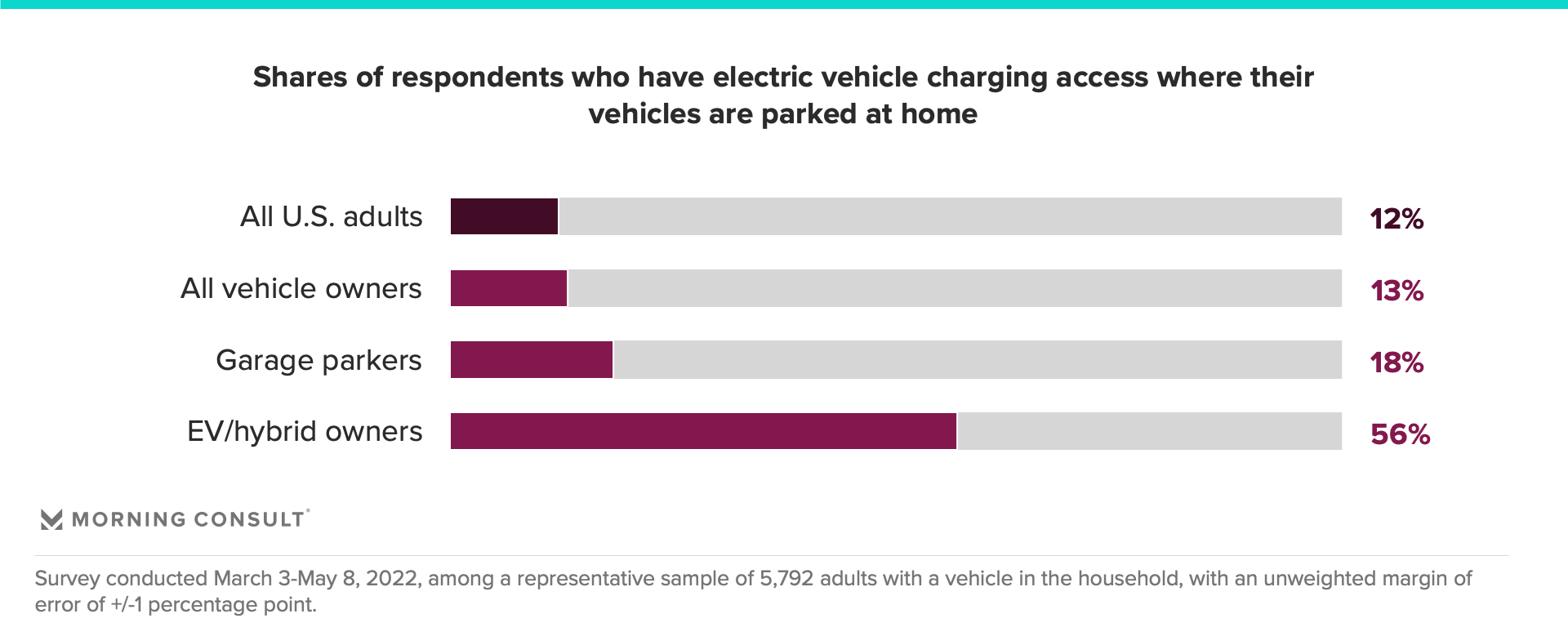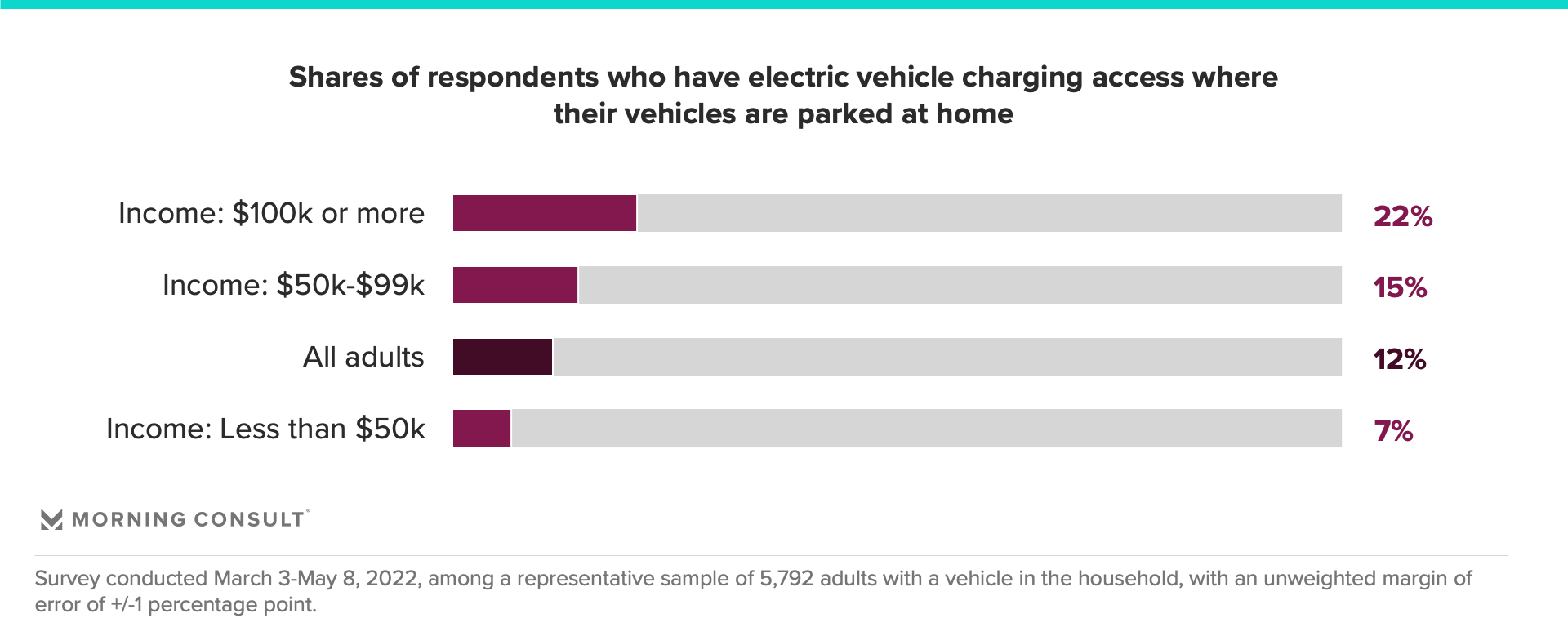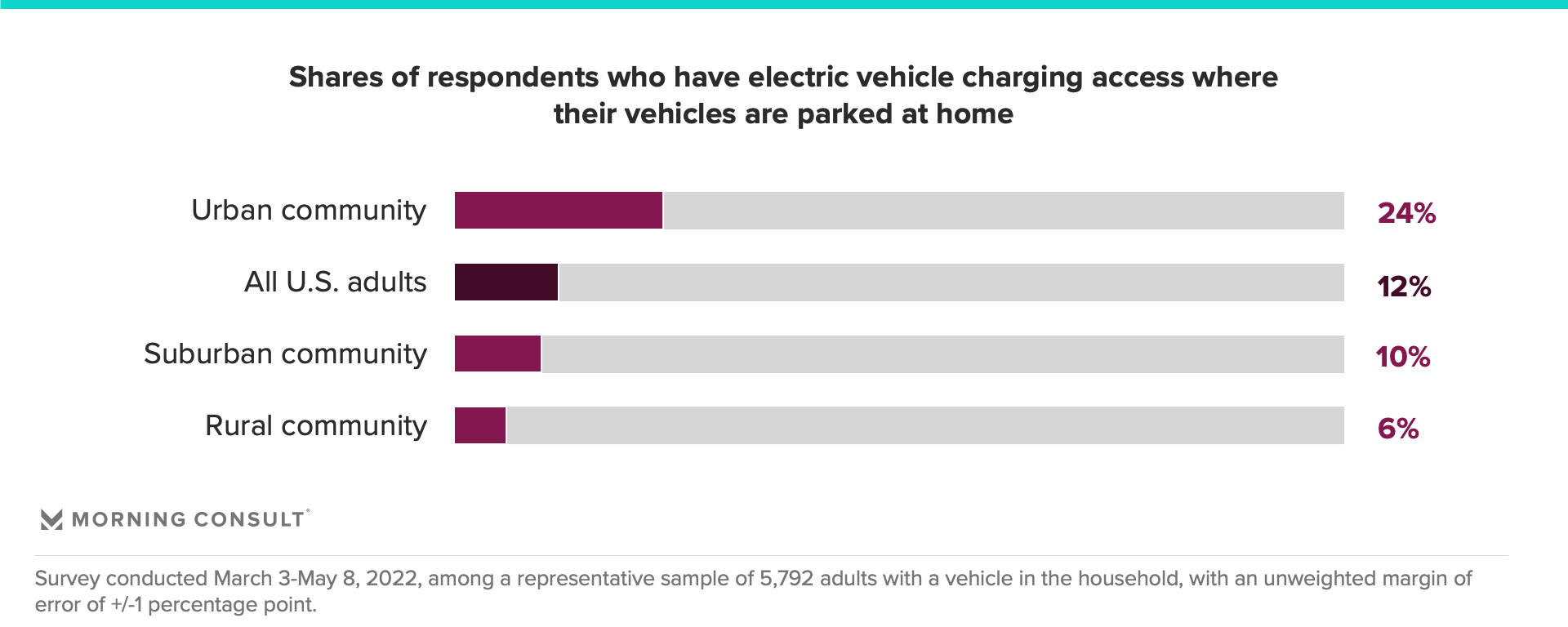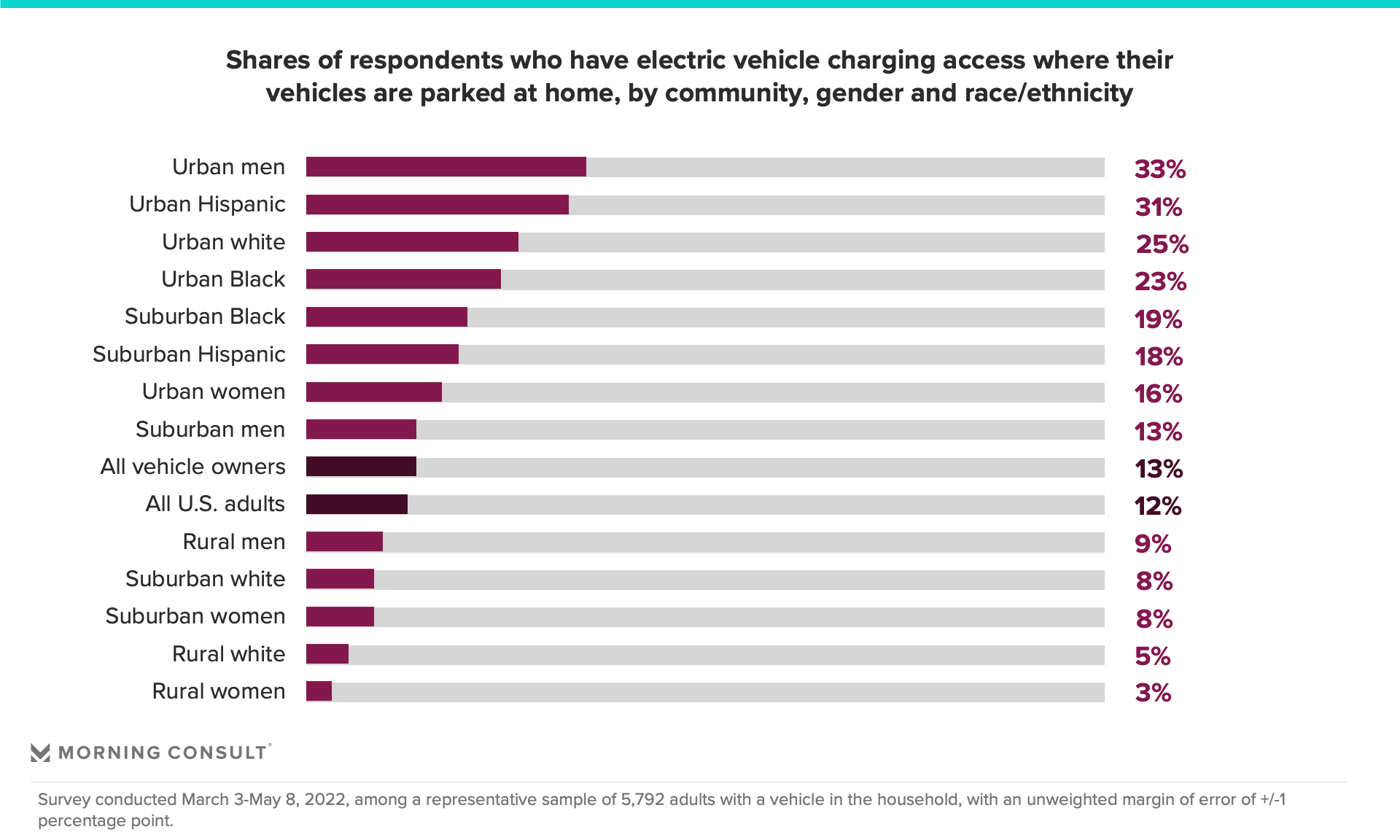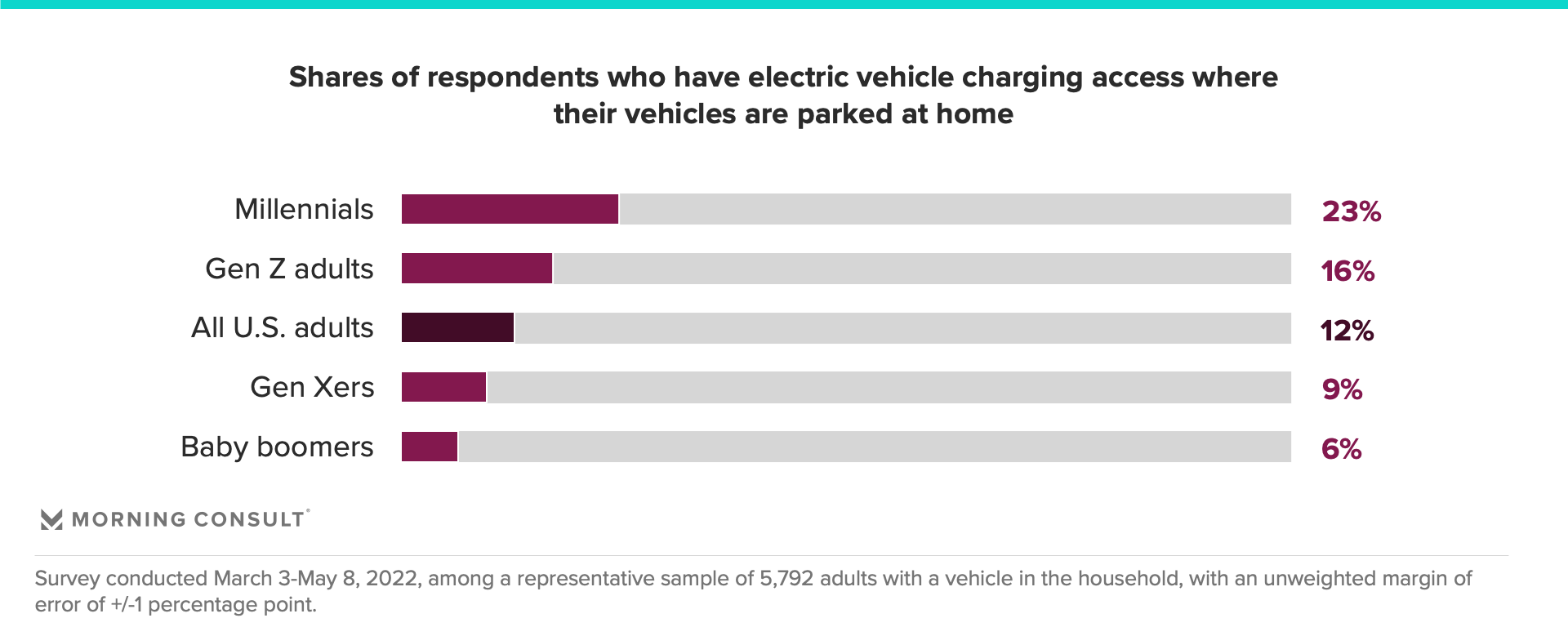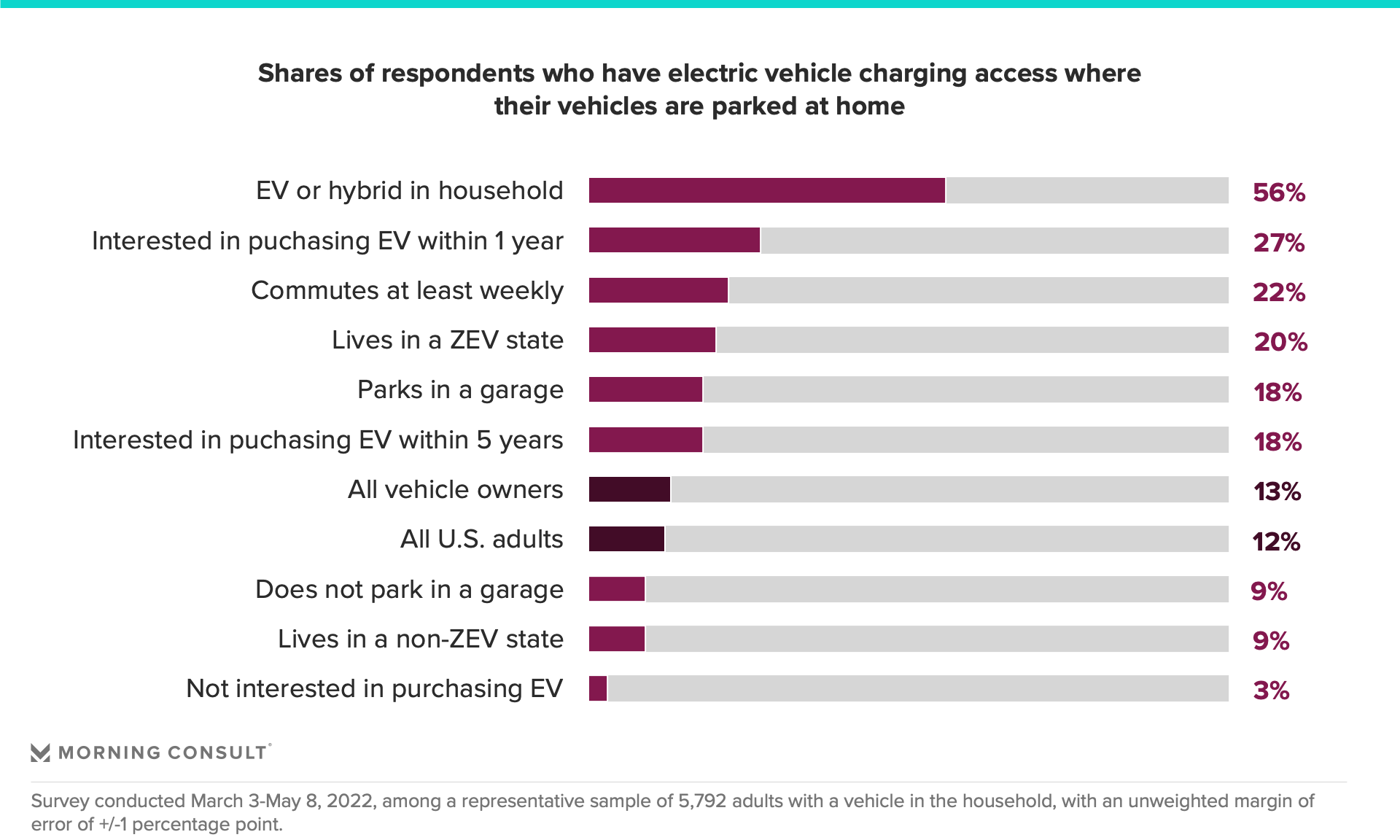Choppy Charging Access Hampers EV Growth Potential Much More Than It Appears on the Surface

Having continuous, convenient electric vehicle charging access is a necessary component of EV ownership. As auto manufacturers struggle to entice more electric vehicle enthusiasts into their fold, they need to understand how deeply the lack of charging access is cutting into their potential market — and act on it.
Quick and convenient charging access remains one of the largest barriers to electric vehicle consideration in the United States. Nearly half (44%) of U.S. adults who aren’t interested in purchasing an EV within the next five years cited a lack of charging infrastructure as a major factor for their disinterest.
Morning Consult research shows it’s clear why: Just 12% of U.S. adults have access to EV charging at home. Although that figure ticks up among those who actually own an EV or hybrid, it only climbs to just over half.
Automotive industry leaders should note the wide chasm between those who have EV charging access and those who do not. And nonautomotive brands that play into the mobility ecosystem, such as convenience stores and gas stations, should grasp the immense potential in setting up charging points for their customers who need them to keep on the move in EVs. Those who are first to market and can aggressively ramp up charging points across their footprint can gain an important first-mover advantage, allowing them to acquire and maintain loyal customers, as consumers tend to trust brands that provide a positive, consistent experience.
Before going deeper, it’s important to understand how parking location impacts charging access. With just 36% of vehicle owners parking in a garage and only 18% of those folks having direct charging access, industry leaders have to leap a massive hurdle just to penetrate the white space of vehicle owners who don’t park in their garages and struggle to find viable charging options.
When it comes to charging access, there is a great divide among the haves and have-nots
Morning Consult research shows much variation in charging access below the surface. One of the largest gaps in charging access is based on income levels. While 22% of those with annual household incomes of $100,000 or more report having access, that figure drops to 7% among those in households that make below $50,000 annually.
This is a critical divide for consumers because EVs are already significantly more expensive than traditional vehicles. In fact, last year, the average price for EVs was $10,000 more than the industry average — not enough to even offset the $7,500 federal EV tax credit currently in place. Most lower-income households won’t stand a chance to purchase EVs unless both pricing and charging options become much more affordable and accessible.
Looking further into the data, community also plays a big role in access.
We find that audiences that skew higher than average in charging access tend to be male, more ethnically diverse and concentrated in urban areas. By contrast, many consumers have little to no access to EV charging, particularly those who are female, white, older and live in rural areas.
Automakers face a huge upward climb in getting underserved consumers access to charging, particularly within the gender and community gaps. And it gets even more arduous when looking at it from a generational perspective across regions in the country.
Millennials report the most charging access overall. And although Gen Z adults are the least likely of all age groups to own a vehicle — given their young age and lower spending power — 16% reported having charging access. This will be an important audience to entice in the future, as younger consumers tend to be more interested in purchasing EVs — 23% of Gen Z adults and 27% of millennials are very interested in purchasing an EV within the next five years, compared with 20% of all adults.
EV infrastructure investment has clearly sown many seeds along the coasts and in the South while failing to penetrate much into the Midwest. In fact, several consumers in the Midwest have little to no access to EV charging, particularly baby boomers, who report the least charging access across the country compared with their younger counterparts. This is surprising because baby boomers tend to have higher incomes than younger consumers, and it shows that age trumps location when it comes to charging access.
It is critical for automotive leaders and other mobility stakeholders to work to deepen access in areas that are served relatively well and expand infrastructure to the large swaths of the Midwest population that report a dearth of available options. And more education and outreach to baby boomers, who clearly are more reticent about purchasing and using EVs, could go a long way. This is a particular opportunity for traditional automakers that produce EVs, which baby boomers tend to favor over purely electric vehicle manufacturers like Tesla Inc.
Another poke beneath the surface reveals more nuances in charging access disparity
Many other factors play into whether consumers have adequate charging access, such as their interest in purchasing EVs, how they use their vehicles and whether they reside in a location where policy favors EV sales, such as the mandated zero-emission vehicle states.
Those with EVs or hybrids were the most likely to report access to charging — but only 56% have regular access. There seems to be a relationship between interest in EVs and charging access — those with more serious interest are also more likely to have access. Automakers should build on the loyalty of EV owners by helping them expand or enhance their charging options while providing outreach via charging education to those in various purchasing windows.
Looking through a policy lens, the Biden administration’s announcement in February to grant $5 billion over the next five years to support EV charging infrastructure development, particularly along the U.S. highway system, is a critical step toward ramping up the charging footprint. And it’s interesting to note that while 20% of adults in mandated zero-emission vehicle states reported having charging access, only 9% of those in non-ZEV states said the same. Clearly, policy sparks more access.
A side benefit to the new charging infrastructure is that it should lengthen the distance of road trips people with EVs are willing to take. From March through May, 35% of adults reported taking a road trip of more than 300 miles, but only 23% of electric or hybrid vehicle owners traveled the same distance. Beyond this, a secondary grant program set to be announced later this year, which will focus on providing charging access to rural and other underserved communities, will be critical to broadening access for everyone.
Beyond researching, educating and properly targeting consumers who might be interested in EVs, automakers must work closely with technology providers and policymakers to develop more widespread charging solutions. And other stakeholders like utility companies can get in the game by providing education, discounts and incentives to reduce the installation costs of EV chargers, as well as lessen the mystery of operating them conveniently and efficiently.
Lisa Whalen previously worked at Morning Consult as an automotive and mobility analyst.
